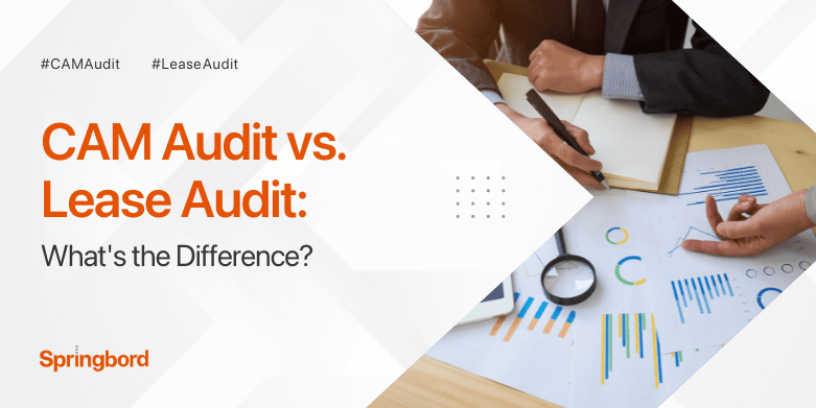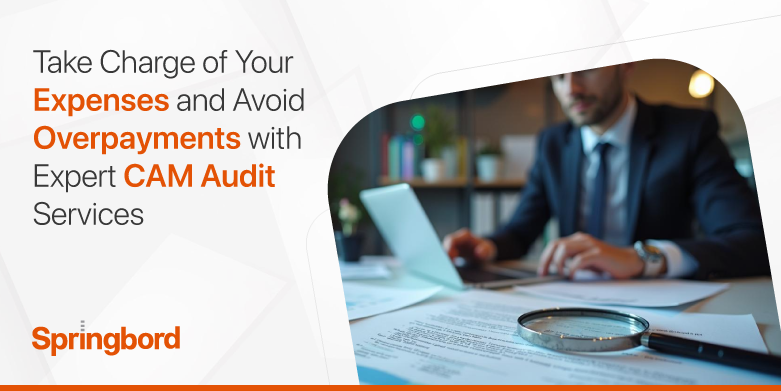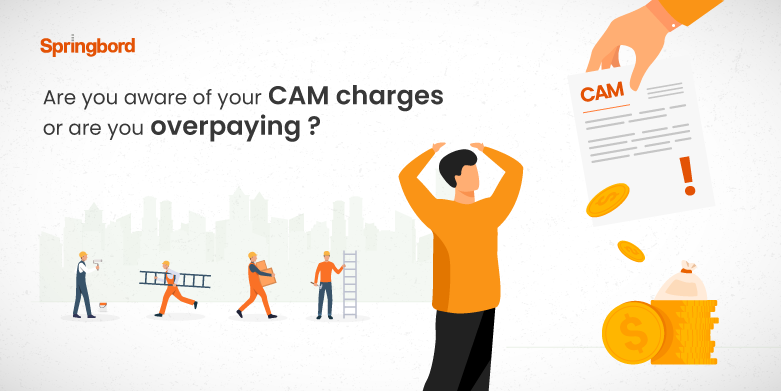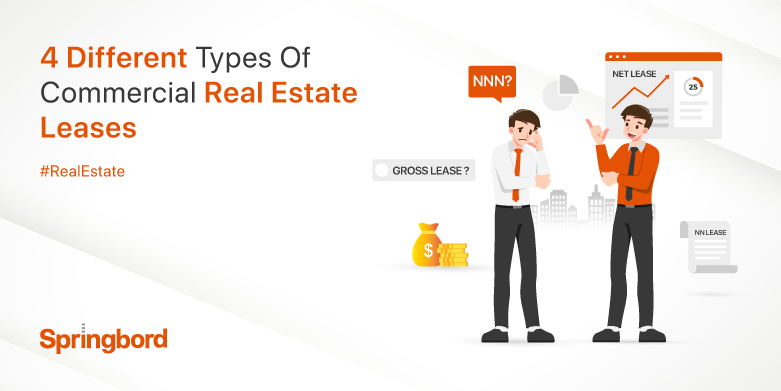 Read time 9 min
Read time 9 minCAM audits and lease audits play significant roles in the financial oversight of commercial properties. A CAM audit focuses specifically on the common areas shared by multiple tenants within a property, ensuring that the expenses allocated for maintenance, repairs, and other shared services are reasonable and in compliance with lease agreements.
On the other hand, lease audits encompass a broader scope, examining the entire lease agreement and financial records to verify the accuracy of charges, payments, and any discrepancies that may exist between the tenant and landlord. While both audits involve financial scrutiny, they differ in terms of focus and the depth of analysis performed.
II. CAM Audit: Exploring the Essentials
A. Definition and Purpose of CAM Audit
A CAM audit, short for Common Area Maintenance audit, is a thorough examination of the expenses associated with the common areas of a commercial property. The purpose of a CAM audit is to ensure the accuracy, transparency, and fairness of the costs passed on to tenants for the maintenance and operation of shared spaces within a property. By conducting a CAM audit, property owners and tenants can identify and address any discrepancies, errors, or overcharges related to common area expenses.
B. Scope of CAM Audit
The scope of a CAM audit typically encompasses various components, including common area maintenance expenses and CAM reconciliations and audits. Common area maintenance expenses refer to the costs incurred for the upkeep, repair, and management of shared spaces within a commercial property. These expenses may include landscaping, cleaning, security, utilities, repairs, and maintenance services. CAM reconciliations and audits involve the review and analysis of the financial statements and records to ensure the accuracy and validity of the charges billed to tenants.
C. Key Components of CAM Audit
Common Area Maintenance Expenses In a CAM audit, it is crucial to analyze and scrutinize the common area maintenance expenses in detail. This involves examining invoices, receipts, contracts, and other relevant documentation to verify the charges billed to tenants. By carefully reviewing these expenses, property owners can identify any unjustified or inflated costs, duplicate charges, or expenses that do not comply with the lease agreements.
CAM Reconciliations and Audits CAM reconciliations and audits are an essential part of the CAM audit process. These involve comparing the estimated common area maintenance charges with the actual expenses incurred during a specific period. By conducting reconciliations, property owners can ensure that the charges billed to tenants align with the agreed-upon terms and accurately reflect the expenses related to the common areas.
D. Benefits of CAM Audit
Cost Control and Reduction A CAM audit provides property owners with an opportunity to gain better control over their maintenance expenses. By identifying any unnecessary or inflated costs, property owners can take appropriate measures to reduce expenses without compromising the quality of services provided to tenants. This cost control can lead to significant savings in the long run.
Identifying Inaccuracies and Errors CAM audits help uncover inaccuracies and errors in the billing and invoicing process. It allows property owners to detect any discrepancies or miscalculations in the common area maintenance charges, ensuring that tenants are only billed for the services they actually receive. By rectifying these errors, property owners can maintain transparent and trustworthy relationships with their tenants.
Enhancing Transparency and Tenant-Landlord Relationships By conducting CAM audits, property owners demonstrate their commitment to transparency and fairness in financial matters. When tenants are assured that the common area expenses are accurately calculated and justified, it fosters trust and strengthens the tenant-landlord relationship. CAM audits provide a platform for open communication and cooperation between property owners and tenants, leading to a harmonious business environment.
III. Lease Audit: Unveiling the Fundamentals
A. Definition and Purpose of Lease Audit
A lease audit involves a comprehensive review and analysis of the financial aspects of a commercial lease agreement. The purpose of a lease audit is to verify the accuracy of rent calculations, ensure compliance with lease terms and conditions, and identify any financial risks or discrepancies that may exist between the tenant and landlord.
B. Scope of Lease Audit
The scope of a lease audit extends to various components, including rent calculations and adjustments, operating expense audits, and compliance with lease terms and conditions. By examining these areas, property owners and tenants can ensure that all financial obligations outlined in the lease agreement are being fulfilled accurately and fairly.
C. Key Components of Lease Audit
Rent Calculations and Adjustments Rent calculations and adjustments form a critical part of a lease audit. This involves verifying that the rental amounts billed to tenants align with the terms stipulated in the lease agreement. It also includes reviewing any adjustments made to the rent, such as escalations or changes based on the terms outlined in the lease.
Operating Expense Audits
Operating expense audits involve scrutinizing the expenses incurred by the landlord and passed on to the tenant as part of the lease agreement. These expenses may include property taxes, insurance, maintenance costs, utilities, and other operating expenses. By conducting operating expense audits, tenants can ensure that they are being charged appropriately and that the expenses are in line with the lease provisions.
Compliance with Lease Terms and Conditions
Lease audits also focus on verifying compliance with the terms and conditions outlined in the lease agreement. This includes ensuring that both the tenant and landlord are fulfilling their respective obligations as specified in the lease. It may involve reviewing requirements related to maintenance responsibilities, repair obligations, insurance coverage, subleasing provisions, or any other terms specified in the lease agreement.
D. Benefits of Lease Audit
Expense Verification and Cost Recovery
One of the primary benefits of a lease audit is the opportunity for tenants to verify the accuracy of the expenses charged by the landlord. By conducting a thorough review of the lease-related expenses, tenants can identify any overcharges, duplicate billings, or unjustified costs. This verification process can lead to cost recovery and significant savings for tenants.
Mitigation of Financial Risks
Lease audits help mitigate financial risks for both tenants and landlords. By ensuring compliance with lease terms and conditions, potential disputes and legal issues can be avoided. Additionally, lease audits provide an opportunity to identify any financial risks associated with inaccurate or misleading financial statements, enabling timely resolution and risk mitigation.
Identification of Lease Compliance Issues
Through lease audits, tenants and landlords can identify any instances of non-compliance with the lease terms and conditions. This may include situations where either party has failed to fulfill their obligations or where there are discrepancies in the interpretation or execution of the lease agreement. By addressing these compliance issues promptly, potential conflicts can be resolved, and the lease agreement can be upheld.
IV. A Comparative Analysis: CAM Audit vs. Lease Audit
A. Differentiation in focus and objectives
When it comes to commercial real estate, understanding the difference between CAM (Common Area Maintenance) audit and lease audit is crucial for business owners. While both types of audits aim to ensure lease compliance and financial accuracy, their specific focus and objectives set them apart.
A CAM audit primarily examines the expenses associated with maintaining and operating common areas within a commercial property. These areas include shared spaces such as lobbies, hallways, parking lots, and elevators. The objective of a CAM audit is to verify that the tenant is being charged appropriately for their share of these expenses, as outlined in the lease agreement. This audit ensures transparency and prevents tenants from overpaying for common area maintenance costs.
On the other hand, a lease audit encompasses a broader scope. It scrutinizes the financial aspects of the entire lease agreement, including both base rent and additional expenses beyond CAM charges. The primary goal of a lease audit is to uncover any potential errors or discrepancies in the lease terms, ensuring that the tenant is not overcharged or subjected to incorrect calculations. Lease audits typically cover aspects such as rent escalations, operating expense reconciliations, property tax calculations, and other financial components mentioned in the lease contract.
B. Variations in audit scope and components
While both CAM audits and lease audits serve to protect the tenant’s financial interests, their scopes differ significantly. CAM audits are narrower in focus, concentrating solely on the expenses related to common area maintenance. This involves reviewing invoices, contracts, and other documentation to verify the accuracy of charges attributed to the tenant.
In contrast, lease audits cover a more extensive range of components within the lease agreement. These audits assess not only the CAM charges but also delve into rent calculations, pass-through expenses, and various clauses stipulated in the lease contract. Lease audits often involve a comprehensive analysis of financial statements, lease abstracts, tenant allowances, and other lease-related documentation to ensure compliance and accuracy.
C. Overlapping areas and complimentary benefits
Although CAM audits and lease audits differ in their specific objectives and scopes, there are overlapping areas where the two audits converge. Both audits strive to identify billing errors, overcharges, or instances where the landlord may be attempting to pass on inappropriate expenses to the tenant. By examining lease provisions, financial statements, and invoices, both audits work towards fair and accurate financial transactions between landlords and tenants.
Moreover, CAM audits and lease audits offer complementary benefits to business owners. A CAM audit primarily focuses on shared common area expenses, ensuring that tenants are charged fairly and transparently. By identifying any discrepancies or inaccuracies, CAM audits can help tenants reduce their operational costs and prevent unnecessary financial burdens. Lease audits, on the other hand, encompass a broader financial assessment, safeguarding tenants from potential financial liabilities resulting from inaccurate rent calculations or misleading lease clauses.
D. Considerations for business owners in choosing between CAM audit and lease audit
Business owners should carefully consider their specific needs and circumstances when deciding between CAM audits and lease audits. Factors such as the size of the commercial property, lease complexity, and the potential financial impact on the business should be taken into account.
CAM audits are particularly valuable when the common area expenses account for a significant portion of the overall lease charges. If the property has extensive shared spaces and the lease agreement allocates substantial CAM charges, a CAM audit becomes essential. By verifying the accuracy of these expenses, business owners can ensure they are not overpaying for common area maintenance.
On the other hand, lease audits are essential for businesses leasing larger spaces or properties where additional expenses beyond CAM charges are significant. Lease audits thoroughly examine the entire lease agreement, offering protection against potential errors or discrepancies in rent calculations, pass-through expenses, and other financial aspects. For businesses with complex lease agreements, a lease audit becomes crucial to avoid financial risks and ensure fair treatment.
V. Best Practices for Outsourcing CAM Audit and Lease Audit
A. Evaluating service providers’ expertise and track record
When considering outsourcing CAM audits or lease audits, business owners must evaluate service providers’ expertise and track record in the industry. Look for companies with specialized knowledge in commercial real estate auditing, specifically CAM and lease audits. Assess their experience, certifications, and client testimonials to ensure they have a proven track record of delivering accurate and reliable audit services.
B. Ensuring data security and confidentiality
Outsourcing CAM audits and lease audits involves sharing sensitive financial and lease information. It is vital to select service providers that prioritize data security and confidentiality. Evaluate their data protection measures, encryption protocols, and information handling procedures to ensure your business’s financial and lease data remains secure throughout the auditing process.
C. Customization and scalability of services
Every business has unique needs and requirements. When outsourcing CAM audits and lease audits, it is essential to partner with service providers that offer customized solutions. Look for providers who can tailor their audit processes to fit your business’s specific lease terms and financial objectives. Additionally, consider the scalability of their services to accommodate your business’s growth and changing audit needs over time.
D. Collaboration and communication strategies
Effective collaboration and communication are vital for a successful outsourcing partnership. Choose service providers who prioritize clear and timely communication, provide regular updates on the audit progress, and address any questions or concerns promptly. A collaborative approach ensures that business owners have visibility into the audit process and can actively participate in resolving any issues that arise.
Conclusion:
In conclusion, CAM audits and lease audits are distinct processes that contribute to the financial integrity of commercial property management. CAM audits concentrate on shared expenses related to common areas, ensuring fairness among tenants, while lease audits encompass a comprehensive examination of the lease agreement and financial records.
By understanding the differences between these two audits, companies like Springbord can effectively navigate property management challenges, maintain transparency, and foster positive relationships with tenants and landlords.







